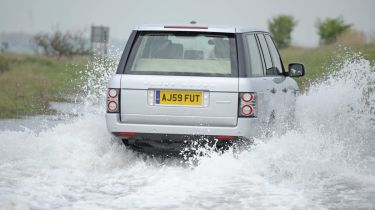Range Rover TDV8 Autobiography
British star has topped 4x4 tree for decades, but is it still the car to beat?
Imagine a car which can go anywhere and do pretty much anything, and the Range Rover is one potential outcome. With a look that hasn’t changed fundamentally through three generations, the latest model’s boxy shape is instantly recognisable. Although the British 4x4 is wider and taller than the GL, it is shorter than its seven-seat rival and has a more compact wheelbase.
Inside, the Range Rover’s five-passenger layout doesn’t provide the flexibility of the Mercedes, but the cabin doesn’t disappoint. The luxurious rear seats and large glass area create an airy ambience and a sense of space. In topAutobiography spec, the chairs are heated, cooled and recline, too.
They don’t fold fully flat, though, so the maximum load area trails the vast GL’s by 544 litres. Even with the seats in place, the Range Rover’s 535-litre boot is 215 litres smaller than its rival’s, but there’s still more than enough space for luggage. The classic split tailgate is genuinely handy – you can perch on the back without dirtying your legs on the bumper – while a full-size spare wheel nestles below the boot floor.
Yet it’s the cabin’s palatial ambience that sets the Range Rover apart. The craftsmanship of the leather upholstery and attractiveness of the overall design make the Mercedes seem rather dull in comparison.
Used - available now

2018 Volkswagen
Up
15,518 milesManualPetrol1.0L
Cash £9,703
2024 Volkswagen
Tiguan
17,069 milesAutomaticDiesel2.0L
Cash £32,038
2022 Volkswagen
Golf
33,366 milesAutomaticPetrol1.5L
Cash £21,106
2018 Ford
Kuga
92,588 milesManualDiesel1.5L
Cash £8,700Unfortunately, the new digital dials look cheap and uninspiring, while a limited range of wheel and seat adjustment means long-legged drivers end up sitting too close to the dash. The lofty seating position provides great visibility over the car’s famously huge bonnet, though, and it’s very comfortable. Air-suspension and variable dampers deliver an impressively cushioned ride, so the sense of serenity continues on the move. However, the Range Rover doesn’t feel as composed or responsive as its rival in bends. Here, prodigious body roll combines with low-geared steering which requires a lot of wheel twirling, forcing you to adopt a relaxed approach to cornering.
Get carried away and the effective stability control system reins you in before there’s any serious loss of grip, so the Range Rover never feels dangerously unstable. Its huge 3,200kg weight – 650kg more than the GL’s – does not help its braking performance, though, and it recorded longer stopping distances than the Merc.
The car lagged behind in our performance tests, too. It took an extra 1.2 seconds to sprint from 0-60mph – achieving this in 9.1 seconds – and, with 60Nm less torque than the GL, response in kickdown was also slower. You certainly wouldn’t describe it as slow, but power isn’t its main strength. Instead, it majors on smoothness and refinement.
The engine never becomes intrusive and it suits the car’s relaxed persona brilliantly, as does the six-speed gearbox.
Also, Land Rover’s award-winning Terrain Response System has been enhanced to improve the Range Rover’s already legendary off-road ability.
Choose Autobiography trim and you won’t want for goodies, either. It comes packed with technology, but commands a £10,390 premium over the GL. Still, the well equipped Vogue undercuts the Merc by £850 so there’s no need to be put off by the flagship’s hefty price.
And while it seems wrong to praise a car which emits 294g/km for its CO2 emissions, this machine pumps out less than the Mercedes and recorded superior economy for us. So, if you want the best 4x4, the latest Range Rover still takes some beating.
Details
Chart position: 1
WHY: A revised cabin, mildly restyled looks and enhanced suspension promise to keep the Range Rover at the top of the class.







